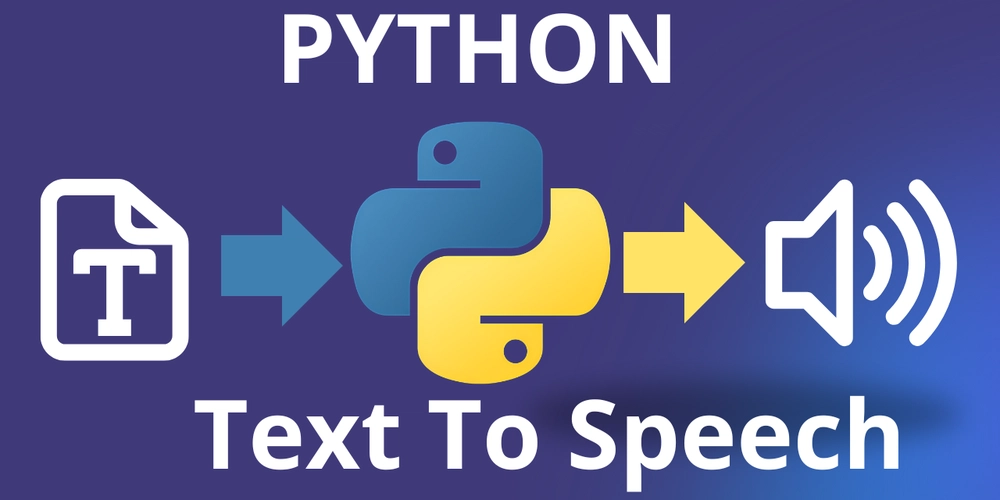Have you ever wanted to turn text into natural-sounding speech directly from your computer? With Python, it’s easier than ever! By combining Microsoft Edge’s neural voices (via the edge-tts library) and Python’s built-in tkinter GUI framework, we can create a simple yet powerful Text-to-Speech (TTS) application.
This project lets you input text (or upload a file), select a voice, adjust the speaking speed, and save the output as an MP3 audio file.
✨ Features
-
🎤 Multiple Voice Options
Supports various neural voices such as US English, British English, Australian English, Canadian English, Spanish, and more.
-
⚡ Customizable Speech Rate
Adjust speed from -50% (slower) to +50% (faster) using a slider.
-
📝 Flexible Text Input
Enter text directly or upload a text file.
-
💾 Export as MP3
Save the generated speech to your preferred location.
-
🖥️ Clean GUI
Built with
tkinter, offering a simple and user-friendly interface.
Dependencies
Ensure you have Python 3.7+ installed on your system. Then, install the edge-tts module:
pip install edge-tts
📦 Installation
- Clone the repository:
git clone https://github.com/smoothcoode/edge-tts-gui
cd edge-tts-gui
- Install dependencies:
pip install edge-tts
- Run the application:
python main.py
🗣️ Listing Available Voices
To see all available neural voices, run:
python -m edge_tts --list-voices
You’ll find a variety of voices you can experiment with.
🧑💻 Source Code
Here’s the complete Python script that powers the application:
import edge_tts
import tkinter as tk
from tkinter import ttk, messagebox, filedialog
import asyncio
async def generate_audio(text, voice, rate, output_file):
communicate = edge_tts.Communicate(text=text, voice=voice, rate=rate)
await communicate.save(output_file)
messagebox.showinfo("Success", "File saved successfully: " + output_file)
# Initialize main window
root = tk.Tk()
root.title("Text to Speech")
root.geometry("600x400")
# Voice selection
VOICES = [
"en-US-AndrewNeural", "en-US-AriaNeural", "en-US-AshTurboMultilingualNeural",
"en-US-AshleyNeural", "en-US-AvaMultilingualNeural", "en-US-AvaNeural"
]
ttk.Label(root, text="Select a Voice:").grid(column=0, row=0, padx=10, pady=10, sticky="w")
voice_var = tk.StringVar(value=VOICES[0])
voice_dropdown = ttk.Combobox(root, values=VOICES, textvariable=voice_var, state="readonly")
voice_dropdown.grid(row=0, column=1, padx=10, pady=10, sticky="ew")
root.columnconfigure(1, weight=3)
# Speed slider
ttk.Label(root, text="Select a speed Rate").grid(row=1, column=0, padx=10, pady=10, sticky="w")
speed_var = tk.IntVar(value=0)
speed_slider = ttk.Scale(root, from_=-50, to=50, orient="horizontal", variable=speed_var)
speed_slider.grid(row=1, column=1, padx=10, pady=10, sticky="ew")
# Text input
ttk.Label(root, text="Enter a text").grid(row=2, column=0, padx=10, pady=10, sticky="w")
text_box = tk.Text(root, wrap="word")
text_box.grid(row=2, column=1, padx=10, pady=10, sticky="nsew")
root.rowconfigure(2, weight=1)
# Upload file button
def on_upload():
file_path = filedialog.askopenfilename(filetypes=[("Text File", "*.txt")])
if file_path:
with open(file_path, "r") as f:
content = f.read()
text_box.delete("1.0", tk.END)
text_box.insert("1.0", content)
upload_button = ttk.Button(root, text="Upload a text", command=on_upload)
upload_button.grid(row=3, column=1, padx=10, pady=10, sticky="e")
# Generate audio
def on_generate_audio():
voice = voice_var.get()
rate = speed_var.get()
rate_str = f"+{rate}%" if rate >= 0 else f"{rate}%"
text = text_box.get("1.0", tk.END).strip()
if not text:
messagebox.showwarning("Warning", "No text Provided")
return
output_file = filedialog.asksaveasfilename(defaultextension=".mp3", filetypes=[("MP3", "*.mp3")])
if not output_file:
return
asyncio.run(generate_audio(text=text, voice=voice, rate=rate_str, output_file=output_file))
generate_button = ttk.Button(root, text="Generate Audio", command=on_generate_audio)
generate_button.grid(row=4, column=1, padx=10, pady=10)
# Run the GUI
root.mainloop()
🚀 Conclusion
This project is a great starting point for anyone exploring Text-to-Speech applications in Python. By leveraging edge-tts and tkinter, you can create a fully functional GUI tool that makes text come alive as natural-sounding speech.
Whether you want to narrate articles, build accessibility tools, or experiment with voice synthesis, this Python TTS GUI is a practical and fun project to try out.



